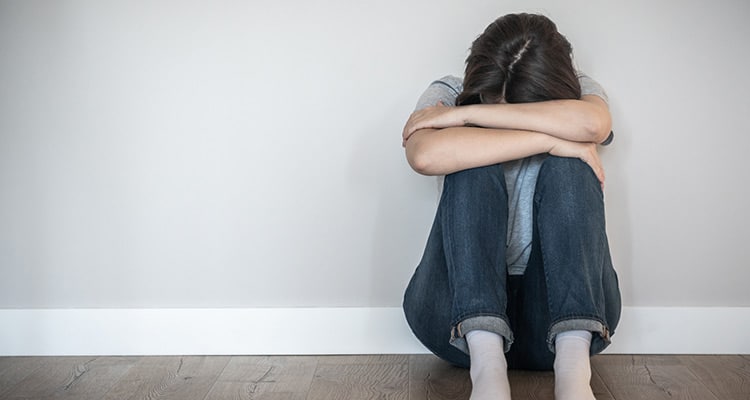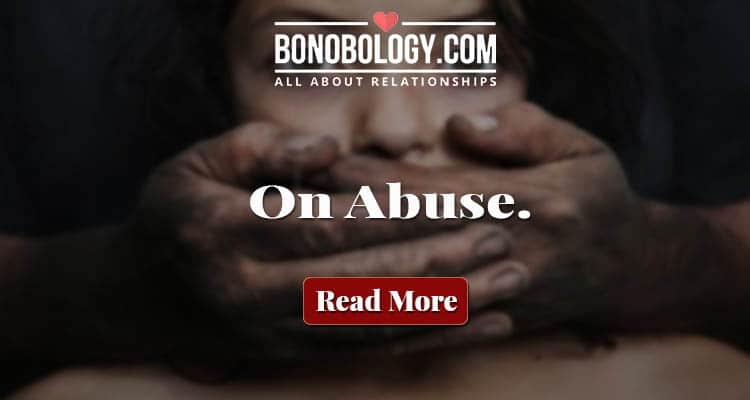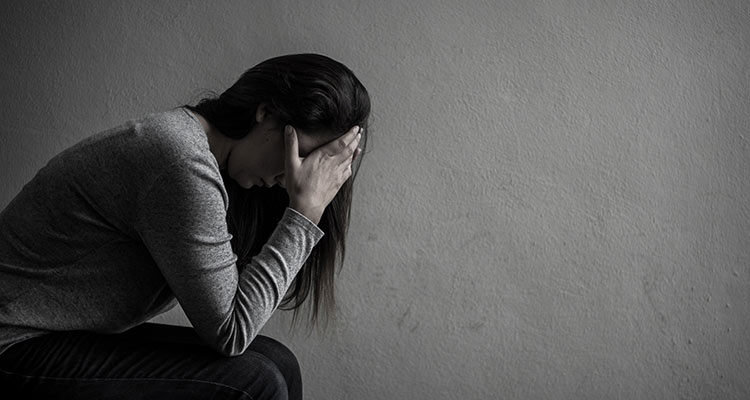What kind of satisfaction does this negative cycle bring to an abuser? Before we move further in exploring these facets, let us first understand why an abuser initiates abuse.
Why do people abuse in intimate relationships?
Simply put, they want to win the power game over their spouse. Parental abuse of children has long-drawn effects that often leads to them perpetrating abuse in their own adulthood. An abuser takes ‘man of the house’ term quite literally and wants things in the house to go his way. He thinks of his wife as a possession or an entity and wants full control over her. Whatever she eats or drinks, wherever she goes, who is part of her circle, the colleagues she is working with, her overall personality undergoes his scrutiny. He may resort to different degrees of abuse to assert his control over her. Unresolved past trauma or anger issues can also trigger the pattern of abuse. His inability to empathise with the victim could also trigger an abusive pattern in a relationship. Earlier it was believed that in a relationship only the man was the abuser and the woman was the victim. But if we look at the abuse statistics in the US we will see that women can also be abusive in intimate relationships. For instance 1 in 4 women and 1 in 9 men experience severe intimate partner physical violence, intimate partner contact sexual violence, and/or intimate partner stalking with impacts such as injury, fearfulness, post-traumatic stress disorder, use of victim services and so on. The National Intimate Partner and Sexual Violence Survey shows 1 in 3 women and 1 in 4 men have experienced some form of physical violence by an intimate partner. This includes a range of behaviors (e.g. slapping, shoving, pushing) and in some cases it might not be considered as “domestic violence” even but has long-term psychological effects. The same survey shows that in a year more than 10 million people, which is 20 people per minute, are physically abused by an intimate partner in the US.
Characteristics Of An Abusive Person
Characteristics of an abuser – whether male or female – are very similar. Abusers are usually very controlling, manipulative people who go through their good and bad phases. Every abusive person exhibits eerily similar characteristics or traits while causing abuse or harm to their partner. A proper awareness of such traits can help many people understand whether their partner exhibits abusive personality traits or not. William Sheer, a professional surfer, talking about a friend and his girlfriend said, “I didn’t know women could abuse till I saw my friend’s girlfriend slapping and kicking him in a fit of rage. She threatened him one day with a kitchen knife, that’s when he quit the relationship and moved town.”Here are some abuser traits that almost always follow a similar pattern.
Charmingly fits the ‘ideal’ image: Usually, the abusers are very cordial with the world outside the four walls of the house. They would wear the brightest smile, take care of the guests like their family, and help in-laws in their times of need. They would fit the image of an ideal husband or wife in the eyes of the societyExpress variations in behaviour: An abuser reflects behaviour that goes to extremes, which is weird in a sense. They may be lovable one minute and lash out the next at their spouse. So, if an abuser switches mood and becomes aggressive or puts on a calm demeanour to confuse the spouse, then this is one red signal to watch out forNo responsibility for their faults: In their eyes, abusers are an epitome of perfect partners. So, in their view, they cannot harm their partner in any wayExpresses no true emotions: An abuser is a master of disguise. In an emotionally charged situation, they put on silence and lets the victim reveal their vulnerabilities. Later, they may use the emotional outburst against their partnerLimit ‘communication’, even with the spouse: They may talk about everyday life, but refrain from heartfelt conversations with the spouse. This way, they keep their personality guarded and silent treatment is a weapon they use to controlThinks a spouse exists for them only: They take the entitlement of the spouse quite literally and feels that the partner’s world should revolve around themRefrain talking about the past: When their wife tries to ask them about the past, abusers often avoid such conversations. This happens in the case of abusers who have issues with their past
Once the signs of abuse start to be prominent in a marriage, the spouse should accept the fact and plan how to deal with it. Women must not stay on in abusive relationships just for the sake of society, family, social status or children.
Do abusers know when they abuse?
Sometimes, an abusive man doesn’t know why he/she is exhibiting such patterns of abuse. Maybe he has witnessed such a toxic relationship between his parents. Maybe he is thinking this is how a normal ‘marriage’ works. If you think your husband harbours such contrasting thoughts in a relationship, yet are confident of his love, then this is the time to talk to him instead of suffering through the abuse. Tell him about the repetitive harm his narcissistic attitude is doing to your relationship. Sometimes toxic girlfriends can turn abusive if they feel that they cannot manipulate or control you enough. Women are capable of physically harming their partners as men are. Meena Kadasamy in her book, When I Hit You, has given a brilliant portrayal of an abuser showing how he totally changes into a monster after marriage, gradually eating into his wife’s self-esteem, controlling every minute of her life and punishing her for anything she does that annoys him. About this man the protagonist writes, “He is the type of anxious husband who stands outside the door of a toilet in a train carriage afraid that I might seize that opportunity to give him the slip, disappear into another far away compartment, get down at a random station and vanish without a trace.” Often, abusers abuse in full awareness as a preferred ‘choice’. This abusive pattern can cause potential harm to their partners and relationship. To assert control over the spouse, they may exhibit love on the outside, but within, want to manipulate you the next moment and make you dance to their tunes. He might sound too sweet, but within the garb of it, might initiate patterns like gaslighting to hamper your confidence. He may make you feel short in your professional achievements and may make fun of them as well. Or she will find potential reasons to turn you down by creating unwanted problems and issues in a relationship. Psychology wise, abuse may sound complicated, but in reality, all abusers follow a complicated pattern, but the same one. To help such victims of household abuse, our Bonobology counsellors have drawn up a pattern in the form of cycle of abuse.
What is the ‘Cycle of Abuse’?
How abusers control their victims? It is through this cycle of abuse. Every abusive relationship is different and is a unique case. However, there are certain patterns underlying in each case. In the 1970s, Lenore Walker developed the cycle of abuse, to better understand the behavioural patterns in an abusive relationship. Lenore Walker is an American psychologist who founded the Domestic Violence Institute, documented the cycle of abuse and wrote The Battered Woman, for which she won the Distinguished Media Award in 1979. Through her theory of Cycle of Abuse she has shown that every abusive relationship goes through a pattern. There can be three or four stages of the cycle of abuse.
1. Tensions Building of abuse phase
In this phase, the abuser is usually seen to withdraw affection and begin to nitpick on small issues. He or she is also moody, makes hurtful comments or threatens with violence. It is marked by passive-aggressive behaviour from the abuser. Communication begins to deteriorate, and tensions begin to mount palpably between the partners. The victim tries to soothe the abuser, fearing the oncoming anger outburst. In this stage, the victim will usually try to avoid things that he or she believes will trigger violence or abuse from the partner.
2. Explosion/Incident of abuse phase
Despite the best efforts of the victim, in this phase of the cycle of abuse, the abuser unleashes maximum physical or emotional abuse on the victim. There may be hitting, choking, and destruction of property. There is also severe emotional abuse, sexual abuse, financial domination, and other forms of controlling behaviour. The victim feels overwhelmed and helpless at this stage. He or she is left physically or mentally bruised, and will usually try to calm the partner down, ignore the outburst, or call the authorities in extreme cases. They will also try to shield their children from harm and may also try to fight back when pushed too much.
3. The Reconciliation/Honeymoon phase
It is this phase that makes many victims believe that the cycle of abuse has been broken. As the name suggests, in this phase, the abuser apologises for the outburst. He or she may become overly affectionate towards the victim, and their children. They believe that it’s over only to realise it’s an unending cycle of apology followed by abuse. In other cases, the abuser might simply ignore the incident. They may also put the blame on the victim, making him or her believe that the outburst was the victim’s fault. The abuser may also become overly sad or even threaten suicide to stop the victim from coming out of the relationship. In most cases, this phase of the cycle of abuse involves great affection being showed by the abuser towards the victims. They might buy them expensive gifts, or take them out to nice restaurants to try and win them back.
4. Repeating the cycle
The calm phase of reconciliation soon fades away into conflicts. This builds up an atmosphere of tension all over again. This begins the cycle of abuse all over again. The victim is subjected to the same treatment again and again, till they decide to break the cycle of abuse. If we are trying to understand the dynamics of abuse in a relationship then we will have to know that the main aim of the abuser is to instill fear in the victim’s mind. This is done by physical harm and emotional abuse. Whatever the victim would be doing, which might be something as innocuous as a trip to the grocery store, they might be fearful that would rub the abuser the wrong way. Would he think I am flirting with the cashier? Would he think I defied him by going to the grocery? Would he be upset that I went out without his permission? These are typical questions that cloud a victim’s mind who is dealing with abuse.
Can abusers change?
In the recent pandemic, all over the world there has been an escalation of domestic abuse during the lockdowns. This is mainly because people have been cooped up at home dealing with anxiety and fear and with no other outlet. So abuse can increase and decrease according to social and environmental situations as well. But it all depends upon the degree of abuse an abuser is causing to your relationship. If the abuser is exhibiting the initial levels of abuse, or mild emotional tactics, then ‘open’ communication can introduce them to this personality flaw and open their eyes to the abuse they are perpetrating. If they look into the problem with an objective and empathetic perspective and are repenting on their mild abusive patterns, then proper marriage counselling could be a right step in this direction. Such abusers, in full awareness, are causing irreparable harm to you and nothing can change their toxic nature. They will employ every possible ploy to make sure things go their own way. So, in such circumstances, it is better to walk out from such a relationship or marriage than to suffer in silence for years and degrade your quality of life. You can avail help from Bonobology’s online panel of experts for personalised guidance on your struggle against relationship abuse. Remember, you are not alone in this battle. We are there with you to identify, deal with and overcome toxic relationships for a better future.





